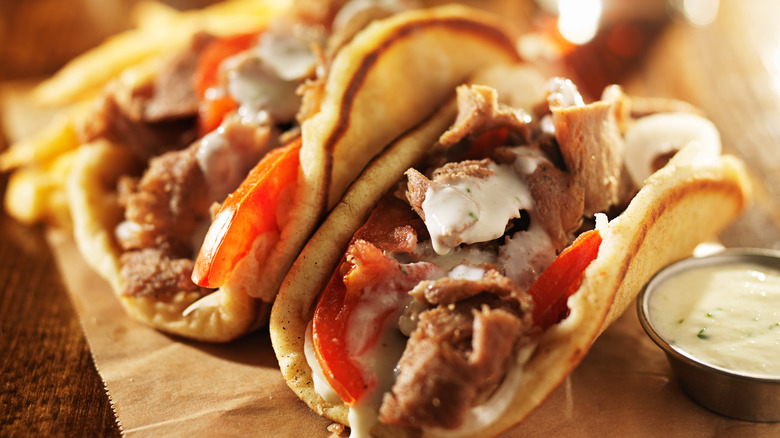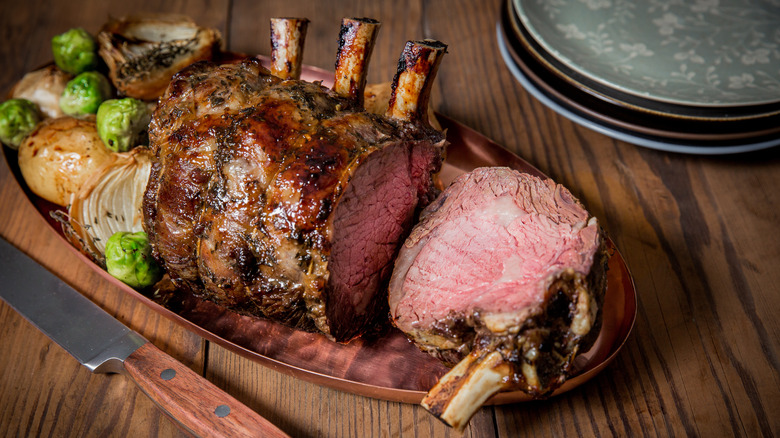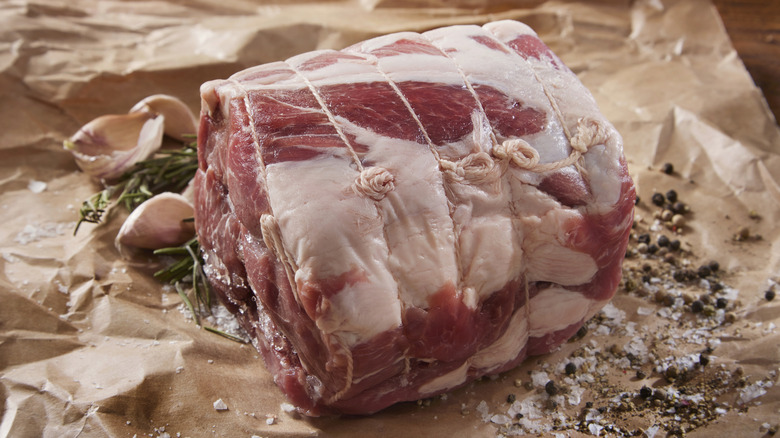The Best Cuts Of Meat For Making Unbeatable Gyros
Gyros are one of those foods that you might not think about that often, but when you do, you're pretty much guaranteed to think they are great. Much like a good Reuben sandwich, a good gyro is enjoyed by almost everyone. The mixture of a soft pita filled with zesty tzatziki sauce, crunchy vegetables, and tender meat is a match made in heaven — just don't confuse them with shawarma, as gyros and shawarma are totally different.
But the thing about gyros is that the meat doesn't have to be one specific type for the whole sandwich (and yes, a gyro is a sandwich) to come together. There's actually a variety of different meat options out there: lamb, beef, chicken, and pork. If you've ever seen a gyro or kebab place, you know the best of these meats always comes on a large upright spit-roaster from which cooks cut tender slices of meat, but chances are you don't have one of those at home (and if you do, your commitment is to be admired).
So what are your best options for each meat in question? While each meat is different, there's a unifying factor: You always want the juiciest, most flavorful cuts. Fattier is often better, but only to a point — what you don't want is a pita filled with unrendered fat globules.
Lamb and beef are the two most common types of gyro meat
Lamb is the most obvious gyro meat, and for good reason: It's the old classic standby. Lamb is the traditional meat used in Greek gyros, and since Greece is where the dish came from, they probably know a thing or two about it. Lamb works well for gyros because it's a naturally fatty, tender meat, and happily, the cut of lamb to use for gyros is the same regardless of whether there's a spit roaster involved: lamb shoulder. You've got two options for cooking it. You can grill lamb shoulder — but if you've got the time and patience, roasting it in the oven will give the connective tissue within more time to break down, so it'll be more tender.
Lamb may be the classic, but just as common around the globe is beef. Cuts of beef tend to be naturally fatty, so it's no surprise it works well. Where the two differ is in the fact that the cut you want to use depends on the cooking method. If you're able to spit-roast, prime rib is great because the fat will render. If you can't do it that way, though, there are other options, and they all fit within the same family of beef: flank steak, skirt steak, or hanger steak. When prepared properly, these three similar cuts of relatively lean meat (at least compared to prime rib) will all come out extremely tender and flavorful, especially if you marinate your steak.
Pork and chicken are less common, but still doable
Pork is another great option for gyro, particularly since it tends to be naturally fatty and tender. The cut you want here is the budget-friendly pork shoulder. Pork shoulder is great on the grill, but it also has enough fat that if you do it that way, you should make sure to trim the excess after cooking. Pork shoulder in a slow cooker is even better because the fat then has a chance to render down and the meat to absorb more juices.
Chicken is the least popular option around the globe, but it's not uncommon to see chicken gyros on menus in America. The only issue with chicken is that it's significantly less fatty than the other gyro meat choices. Because of that, the best solution here is rotisserie, even more so than with lamb, beef, or pork. Fortunately, rotisserie chicken is more readily available in supermarkets than other spit-roasted meats, so you can just buy one and not even have to cook it yourself. Otherwise, you either want to roast a whole chicken in the oven or just use dark meat, which is fattier than white meat.
Whichever meat you use, though, just cook it slowly and with love, and you'll be eating great gyros in no time. And hey, if you have any tzatziki left over at the end, you can always use it in pasta salad.


